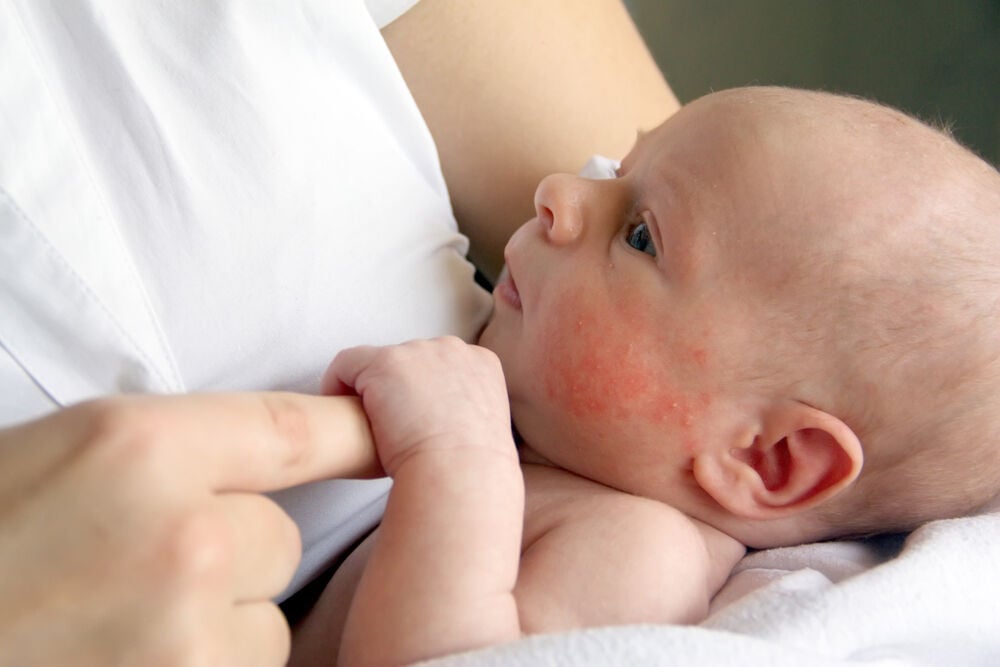-
Tracking cycle
-
Getting pregnant
-
Pregnancy
-
Help Center
-
Flo for Partners
-
Anonymous Mode
-
Flo app reviews
-
Flo Premium New
-
Secret Chats New
-
Symptom Checker New
-
Your cycle
-
Health 360°
-
Getting pregnant
-
Pregnancy
-
Being a mom
-
LGBTQ+
-
Quizzes
-
Ovulation calculator
-
hCG calculator
-
Pregnancy test calculator
-
Menstrual cycle calculator
-
Period calculator
-
Implantation calculator
-
Pregnancy weeks to months calculator
-
Pregnancy due date calculator
-
IVF and FET due date calculator
-
Due date calculator by ultrasound
-
Medical Affairs
-
Science & Research
-
Pass It On Project New
-
Privacy Portal
-
Press Center
-
Flo Accuracy
-
Careers
-
Contact Us
Blotchy Skin in Newborns: How Soon Will It Go Away?

Every piece of content at Flo Health adheres to the highest editorial standards for language, style, and medical accuracy. To learn what we do to deliver the best health and lifestyle insights to you, check out our content review principles.
Blotchy skin or erythema toxicum: signs and symptoms
Before having a baby, you may only have thought of the skin of a newborn as being as smooth and clear as a supermodel. But looking at your little one’s skin, you can see that the reality is often quite different. The truth is, between birth and one year of age, a baby’s skin can erupt with many different types of blemishes or rashes. And even though this can be upsetting to parents or carers, it’s usually nothing to worry about.
One common example of such a rash is erythema toxicum, which is sometimes called erythema toxicum neonatorum or ETN, or simply newborn rash.
Despite being quite common, many parents have never heard of the condition, and this can result in considerable anxiety. But a little education can go a long way towards reducing the worry of seeing your baby affected by this type of rash. Here’s how to spot the typical signs and symptoms:
Erythema toxicum appears as red rash with tiny (less than 0.5cm in diameter) bumps called papules, which rapidly progress to pustules (puss-filled bumps) with red base. If you’ve ever had a flea bite or seen one on someone else, you’ll know roughly what the rash of erythema toxicum looks like.
There may only be a few of these bumps on the skin or you may find many spread across a wider area. They are typically firm to the touch, and you may notice that some of them secrete a clear fluid that looks similar to pus.
Although it’s common for parents and carers to be upset by how the rash appears, rest assured that these pustules are completely benign — this means that they’re not associated with any type of cancer and usually will not progress. You will also be reassured to know that the condition does not cause your little one any pain or discomfort.
Most commonly, the rash can be found over the trunk and proximal extremities, sparing the palms and soles. It can be somewhat mobile, in that it may initially appear on one part of the body and later be seen on another. It can also disappear from a particular part of the body and reappear in that same location at a later time.
Erythema toxicum varies in how quickly it appears in newborns. It usually becomes visible within 2-5 days. It's very rare within first 24 hours after birth, and it generally resolves in 5-7 days. Most importantly, it poses no danger to your baby — it’s a short-lived and self-limiting condition that will resolve on its own without treatment.

The cause of erythema toxicum is still unknown, but it is believed to be due to pilosebaceous follicle immaturity. Whatever the reason, the rash appears to be part of a range of skin conditions that commonly occur in newborns and young infants.
Ask any pediatrician or other health professional who works in this field and they’ll almost certainly tell you that babies frequently experience a variety of brief, harmless skin disorders that pose no threat to the health. Most are benign and short-lived — they usually pass as promptly as they appear.
How common are red splotches on the skin of newborns?
It’s very common for newborns and babies in the first few weeks of life to have rashes on different parts of the body. When it comes to the frequency of erythema toxicum specifically, estimates vary from 7% to 41% of newborns.
Whatever the case, this condition is far from unusual and is familiar to health professionals who work with babies (or, indeed, others who’ve spent a lot of time with them!).
Red blotchy skin: treatment
You may not like how erythema toxicum blemishes your little one’s lovely skin, but the good news is that the condition is completely self-limiting. This means that the rash will resolve on its own within about a week without medical intervention — there’s no need to either apply any particular skin treatment or to make any other changes to your baby’s normal skincare routine.
And once the rash has passed, you can put the memory of it behind you, as there are no long-term consequences that come from having had the condition.
When to seek medical advice
Considering that erythema toxicum is a short-lived, self-limiting, and completely benign condition, there’s no need to be alarmed if your baby develops this common rash. There are no specific tests for the condition, and diagnosis usually occurs when the infant is being assessed by a pediatrician or family doctor during a routine examination.
Only in rare cases in which diagnosis is challenging will cells be sampled from the rash for microbiological testing in a laboratory. In all cases, be sure to seek medical advice whenever you have concerns about any aspect of your baby's health and wellbeing.
Take a quiz
Find out what you can do with our Health Assistant


Hey, I'm Anique
I started using Flo app to track my period and ovulation because we wanted to have a baby.


The Flo app helped me learn about my body and spot ovulation signs during our conception journey.


I vividly
remember the day
that we switched
Flo into
Pregnancy Mode — it was
such a special
moment.
Real stories, real results
Learn how the Flo app became an amazing cheerleader for us on our conception journey.




